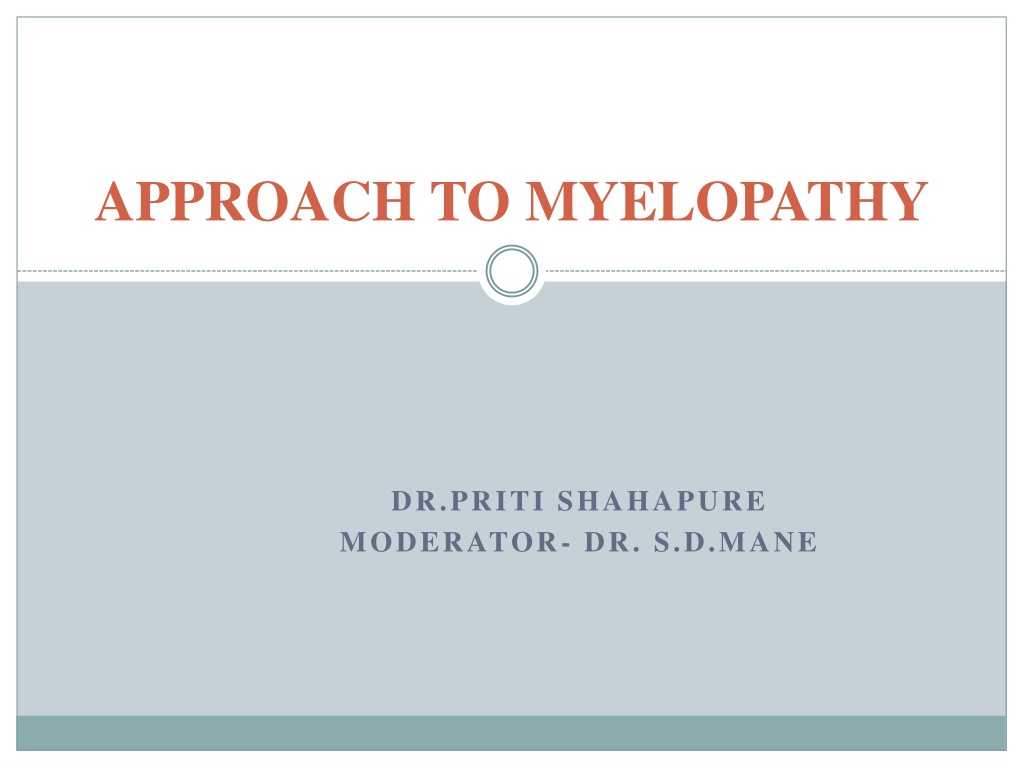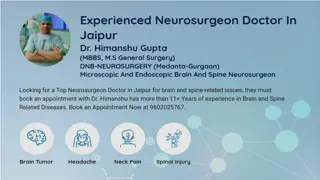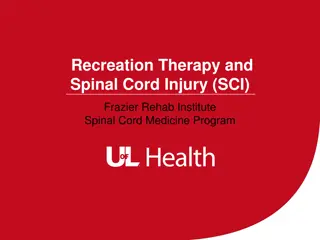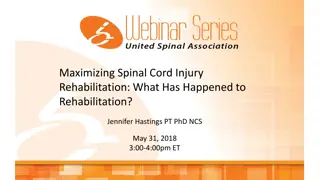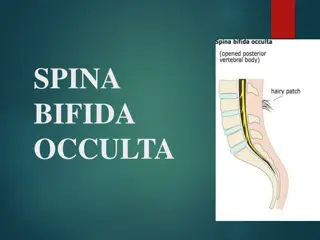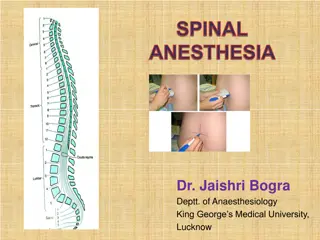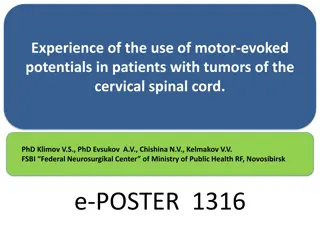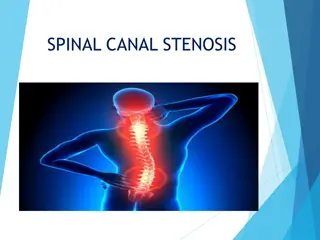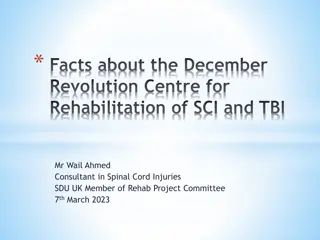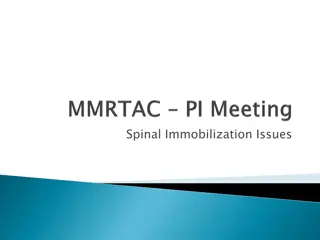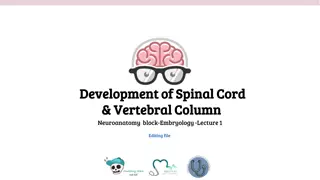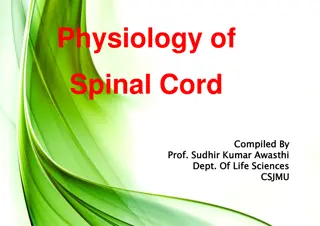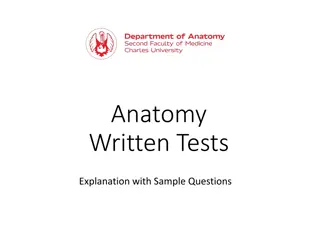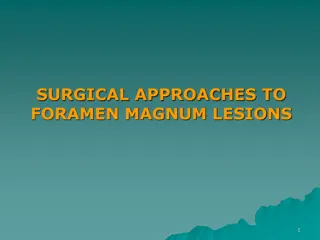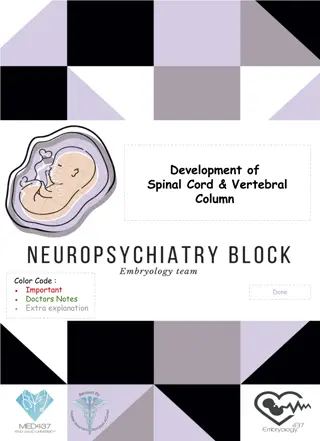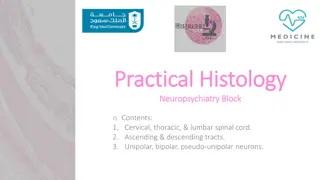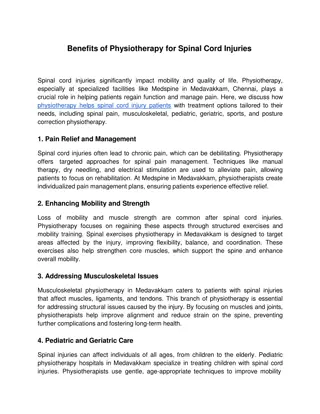Approach to Myelopathy and Spinal Cord Anatomy
Spinal cord anatomy is crucial for understanding myelopathy, a condition affecting sensory, motor, and autonomic functions. Sensory levels, lesion detection, and segmental signs are key in diagnosis. Learn about the levels of spinal cord damage and associated symptoms, providing valuable insights for medical professionals and students.
Download Presentation

Please find below an Image/Link to download the presentation.
The content on the website is provided AS IS for your information and personal use only. It may not be sold, licensed, or shared on other websites without obtaining consent from the author.If you encounter any issues during the download, it is possible that the publisher has removed the file from their server.
You are allowed to download the files provided on this website for personal or commercial use, subject to the condition that they are used lawfully. All files are the property of their respective owners.
The content on the website is provided AS IS for your information and personal use only. It may not be sold, licensed, or shared on other websites without obtaining consent from the author.
E N D
Presentation Transcript
APPROACH TO MYELOPATHY DR.PRITI SHAHAPURE MODERATOR- DR. S.D.MANE
ANATOMY OF SPINAL CORD Spinal Cord is a tubular extension o f the central nervoussystem. It starts from medulla and ends at conus medullaris at lumbarlevel. Its fibrous extension, the filum terminale, ends atthe coccyx. The adult SC is 18 inchlong.
SPINAL CORD levels relative to the vertebral bodies.
Useful markers of Sensory level T4 nipple T10 umblicus T12 Pubic symphysis Lesion at T9 T10( Beevor ssign)
DETERMINING THE LEVEL OF THE LESION 1. Impairment / Loss of sensory, motor and autonomic function below a horizontal level HALLMARK of lesion of the spinalcord Sensory loss due to spinothalmic / posterior column involvement. Motor loss ( paraplegia/paresis, quadriplegia/paresis) with heightened deep tendon reflexes, positive Babinski sign and eventual spasticity. Autonomic function loss in form absent sweating below the implicated cord level and bladder, bowel and sexual dysfunction.
2. Segmental signs A band of hyperalgesia or hyperpathia at upper end of sensory disturbance Fasciculation or atrophy in muscles innervated by one or several segments A decrease or absent deepreflex Along with long tract involvement 3. Spinal shock In case of severe and acute transverse lesions, the limbs may be flaccid rather than spastic with absent reflexes. Which may last for several days-weeks.
Transverse damage at each level of Spinal Cord High Cervical CordLesion Sensory loss over occipital area ( C2) Involvement of spinal accesory nerve Wasting of small muscles of hands Quadriplegia with diaphragmweakness Sensory loss of upper portion of face along with loss of corneal reflex due involvement of spinal nucleus of V cranial nerve
Low Cervical Cord C5 - C6 weakness in deltoid, supraspinatus, lossof power and reflexes in the biceps. C7 weakness is found in triceps, fingerand wrist extensors.(radial nerve) C8 in finger and wrist flexion areimparied.(ulnar nerve) Horner s syndrome occur lesion at anylevel.
Thoracic Cord Sensory level on trunk Site of midline back pain Paraparesis / Paraplegia of lowerlimb Beevor ssignpositive Bladder bowel involvement
Lumbar Cord L2-L4 weakness of Flexion and adduction of thigh Weaken leg extension atknee Loss patellarreflex Exaggerated ankle jerk. L5-S1 paralyze movement of foot andankle Weakness of flexion atknee Weakness of extension of thethigh Loss of ankle jerks(L5,S1)
Conus Medullaris Syndrome Lesion at vertebral level L2 affects conus medullaris. Bilateral saddle anaesthesia (S3-S5). Presentation-sudden bilateral and symmetrical. Prominent bowel and bladder dysfunction. Loss of anal reflexes (S4-S5) and bulbocavernosus (S2-S4) Loss of anal tone, Impotence Preserved motor function of lower limbs including ankle jerk.
Cauda Equina Syndrome Injury to multiple lumbosacral nerve roots within the spinal canal distal to the termination of the spinal cord. Composed of lumbar, sacral and coccygeal nerve roots. Asymmetric leg weakness and sensory loss. Variable areflexia in lower extremities. Relative sparing of bowel and bladder function.
Special patterns of Spinal Cord diseases Brown-Sequard Syndrome Hemicord lesion Ipsilateral corticospinal weakness Loss of joint position and vibration ( Posterior column) Contralateral Loss of pain and temp sensation ( Spinothalmic tract) one or two levels below the lesion.
Central Cord Syndrome Selective damage to grey matter nerve cells and crossing ST tract surrounding the central canal. Arm weakness out of proportion to leg weakness. Cape distribution of dissociated sensory loss. DTR s diminished or lost in upper limbs while exaggerated in lower limbs. Bladder / Bowelinvolvement is early. Spinal trauma, Syringomyelia, intrinsic caod tumours.
Anterior Spinal Artery syndrome Infarction of cord as a result of occlusion or diminished blood flow in the artery. Extensive bilateral motor, sensory and autonomic function loss below the level of lesion. Vibration and position sense are spared.
Foramen Magnum Syndrome Cortico-spinal leg fibres which cross distal to upper limbfibres are interuppted resulting in weakness of the legs (crural paresis). Around the clock pattern of weakness. Suboccipital pain spreading to neck and shoulders.
Intramedullary and Extramedullary syndromes Intramedullary- lie within the substance of the spinal cord. Extramedullary- lie outside the cord and compress the cord or its vascular supply.
Intramedullary and Extramedullary syndromes Features Radicular pain Sensory deficit Extramedullary Early and common No dissociataion of sensation Lost early Early and prominent Segmental Intramedullary rare Dissociation of sensation common Sacral sparring Less pronounced Marked with widespread atrophy,fasciculations seen Less brisk ,late feature Early Common No bony tenderness Sacral sensation UMN involement LMN Reflexes Autonomic involvement Trophic changes Vertebral tenderness Brisk early feature Late Usually not marked May be sensitive to local pressure Frequent Changes In CSF rare
Extradural extramedullary Local vertebral pain and tenderness with or without radicularpain. Corticospinal tract involvement. Myelopathy with bladder / bowel involvementlater. Mode of onset symmetrical.
Intradural Extramedullary Commonly in vicinity of dorsalroots Radicularpain andparasthesia Posterior column and pyramidal tractinvolvement spastic paresis with sensory disturbance in lowerlimbs Spinal tenderness is not common Mode of onset isasymmetrical. Long duration of symptoms.
Compressive Myelopathies Neoplastic spinal cord compression: 1. Mets from Ca Lung, Breast, kidney, lymphoma, prostate, myeloma ( epidural in origin) M.C- Thoracic spinal column Ca Prostate n ovaries- lumbar/sacral spine through Batsons plexus. Initial symptom-Persistent backpain aggravating on movement,coughing, sneezing. MRI provides excellent resolution of the extent of spinal tumors. Treatment: Glucocorticoids ( dexamethasone upto 40mg daily) to reduce the cord odema F/B local radiotherapy and/ surgical decompression.
Intradural lesions: Slow growing, benign meningiomas, neurofibromas, chondroma, lipoid, or sarcomas. Treatment: surgical resection. Spinal epidural Absess: Midline back/ neck pain, fever, progressive limb weakness. Increased TLC,ESR, CRP. With expansion of the tumour furthur damage occurs with venous congestion and thrombosis. Impaired immune status, IV drug abuse, infection of skin or other tissue. 2.
Mode of spread: 2/3 by hematogenous spread of the bacteria from skin, soft tisssue, or deep viscera. Rest by direct extension thru vertebral osteomyelitis, decubitusulcer, Lumbar puncture or spinal surgery. Organism-Staph,strepto, anaerobes, Myco Tb. Investigations: Blood culture, MRI, LP only in case of encephalopathy( High cervical tap). Treatment: decompressive laminectomy with debridement with broad spectrum antibiotic for at least 6 weeks.
Noncompressive Myelopathies Inflammatory Postinfectious Autoimmune Demyelination Paraneoplastic toxic Hereditary Noninflammatory Spinal cord infarction AVM Vitamin b12deficiency
Syringomyelia Developmental cavity in the cervical cord that may enlarge and cause progressive myelopathy. More than half are associated with chiari 1 malformation. Acquired cavitations termed as syrinx cavities follow trauma, myelitis,necrotic spinal cord tumors.
Presentation: central cord syndrome Asymmetrical Dissociated sensory loss( Cape distribution) and areflexic weakness in upper limbs. Un-noticed burns and injuries, muscle wasting over lower neck, shoulders, arms and hands. With the enlargement of the cavity compression of the long tracts occur leading to spasticity and weakness in the legs, bowel and bladder dysfunction. Extension to medulla- Syringobulbia causes palatal or vocal cord paralysis, dysarthria,horiontal or vertical nystagmus,vertigo and tongue weakness with atrophy.
MRI identifies developmental and acquired syrinx cavities. Treatment: chiari tonsillar herniation may be decompressed with suboccipital craniectomy, upper cervical laminectomy and placement of dural graft. Secondary cavities if symptomatic can be treated with decompression and drainage ( shunt is inserted between cavity and subarachnoid space.
